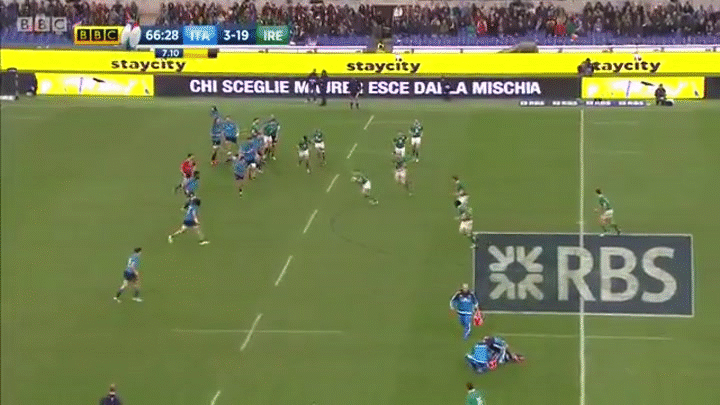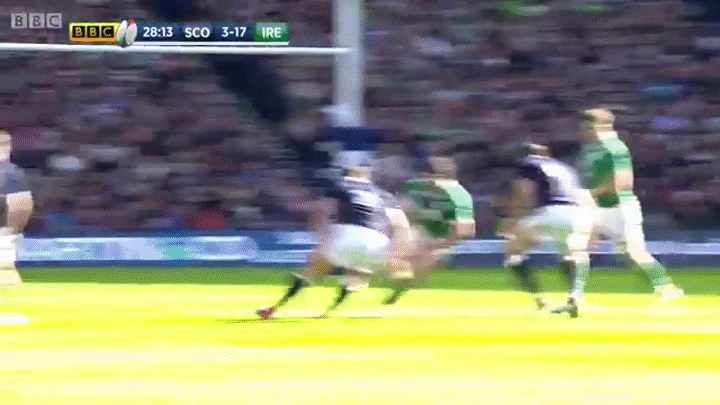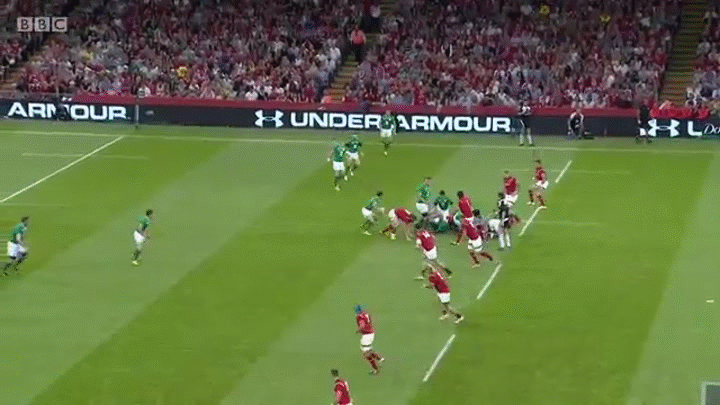O Canada!
So the team is in and it’s not like anything we would have predicted six weeks ago. That weird micro-climate that exists around the Irish squad has created an environment in which some players have flourished and others, seemingly, have wilted. Iain Henderson, Dave Kearney and Keith Earls had all been flagged as potential starters, which was thoroughly deserved after the performances that the produced during the warm-up matches.
But Luke Fitzgerald at inside centre? That’s the kind of curveball that we rarely see from Joe Schmidt and it’s one that will leave Darren Cave once-again wondering what he has to do to get a run-out in a meaningful game.
That said, Ireland will line-up with an incredibly exciting (and largely in-form) back-line this Saturday as they look to get their World Cup rolling with an emphatic victory.
P.S: Get well soon, Robbie Henshaw.
Getting line breaks over try lines
I really enjoyed Gordon D’Arcy’s piece this week on the pitfalls of an offloading game. D’Arcy is a guy with first-hand experience of the training camps over the past two months and it’s going to be interesting to get his insights on how the Irish side is performing.
He talks a lot of sense too about why offloading doesn’t come naturally to Irish players and, then he wrote something else that got me thinking about what else this Irish team needs to get instinctively better at:
“We are going against the grain again by not embracing an offloading game but when Joe puts down a play the players know it will create a line break if executed correctly. We will get three maybe four opportunities in major games. Then it’s about accuracy.”
In modern rugby, a clean line break is the gold dust that all attack-minded players dream of, while it is the stuff of nightmares for defence coaches. A line break will obviously earn your side precious metres but, when it’s well executed, it should normally result in a try, but that’s not always the case when Ireland is involved.
In his piece, D’Arcy references one of just two clean line breaks that Ireland managed during the warm-up loss in Twickenham - praising the timing of Jared Payne’s pass to release Robbie Henshaw down the left wing.
As D’Arcy points out, the break ultimately sets-up the platform for Paul O’Connell’s try, but if you watch the GIF above again you find yourself wondering if that line break shouldn’t have resulted in a try directly. With Simon Zebo hugging the touchline outside him and Payne and Dave Kearney on the inside, Henshaw should have had the confidence to fix George Ford before passing to a teammate. Instead, he opted for the chip and Ford was able to use his body cleverly to shield the ball until support came to clear the line.
It’s a snap decision by Robbie Henshaw (who is at full tilt and is also trying to assess what’s going on around him while also trying to get a read on Ford’s body language) but the chip kick seems like the wrong option in this scenario and a waste of a potential 3-v-1 attack.
Unfortunately, Irish players seem to struggle to convert these precious line breaks when they do occur. The bulk of our tries this season have tended to come from mauls or well-executed clear-outs that create quick ball (and space!) for players to drive into. Tommy O’Donnell’s effort against Italy was a rare example of a clean break that led directly to a try and even then he didn’t need support largely because of the poor Italian tackling.
Crucially though, if O’Donnell had needed supporting runners when he was attempting to break through the tackles of Kelly Haimona (10) and Luca Morisi (12), both Henshaw and Zebo were too far back to accept a pass. Perhaps this is a consequence of the importance that Schmidt’s Ireland place on clearing-out rucks and protecting - trailing players moderate their pace so that they can accelerate into a ruck, rather than busting a gut to get up on the shoulder for an offload.
Communication
However, the running of a good support line is only one-half of battle when it comes to executing a line-break. It’s utterly pointless to run the line in the first-place if your team-mate isn’t at least partially aware of your presence.
It’s of no real surprise that the win over Scotland in this year’s Six Nations was the match when Ireland made their most line breaks. At Murrayfield, with the championship at stake, Ireland made 13 line breaks compared to 0 against France (5 vs Italy, 3 vs England and 4 vs Wales). Perhaps the most exhilarating of those came during the opening-half when Sean O’Brien swatted aside two tacklers and charged towards the Scotland line.
When you watch O’Brien’s break from another angle, you can see that Jamie Heaslip is actually in support. The Leinster no.8 shows his intelligence by trying to weave his way into O’Brien’s line of sight, but perhaps a shout might have been more useful!
Sometimes, of course, a simple shout isn’t going to be enough to get the message across.
During the opening warm-up game against Wales, Ireland were rampant in the opening quarter as they dashed around the fringes of the Welsh defence. They led 25-7 at half-time, but it could easily have been almost double that margin if Ireland had taken their chances. This particular foul-up between Keith Earls and Eoin Reddan will have made for some uncomfortable viewing the following Monday.
Darren Cave and Fergus McFadden do very well to initiate the attack with Cave fixing Dominic Day before passing to McFadden, who brilliantly demonstrates why holding the ball in both hands can be so important.
Reddan and Earls both do well initially but they’re unable to shake-off a determined Mike Phillips, who does well to track backwards without losing sight of the ball carrier. The big failure is that neither Irish player seems to be aware of Felix Jones just a few metres inside of them. Reddan’s feint to the outside creates the space for Earls to pass to Jones, who has a clear run to the line, but instead Earls for the more difficult pass out of the back of his hand to an unsuspecting Reddan.
These may seem like minor mishaps that could befall any team and, ultimately, even an unsuccessful line break normally leads to a gain in territory at the very least.
But, as Gordon D’Arcy points out, Ireland may only get 3-4 such opportunities in the big World Cup games and they must work at becoming more clinical when the chances present themselves.
Download the brand new GoLoud App in the Play Store & App Store right now! We've got you covered!
Subscribe to OffTheBall's YouTube channel for more videos, like us on Facebook or follow us on Twitter for the latest sporting news and content.













